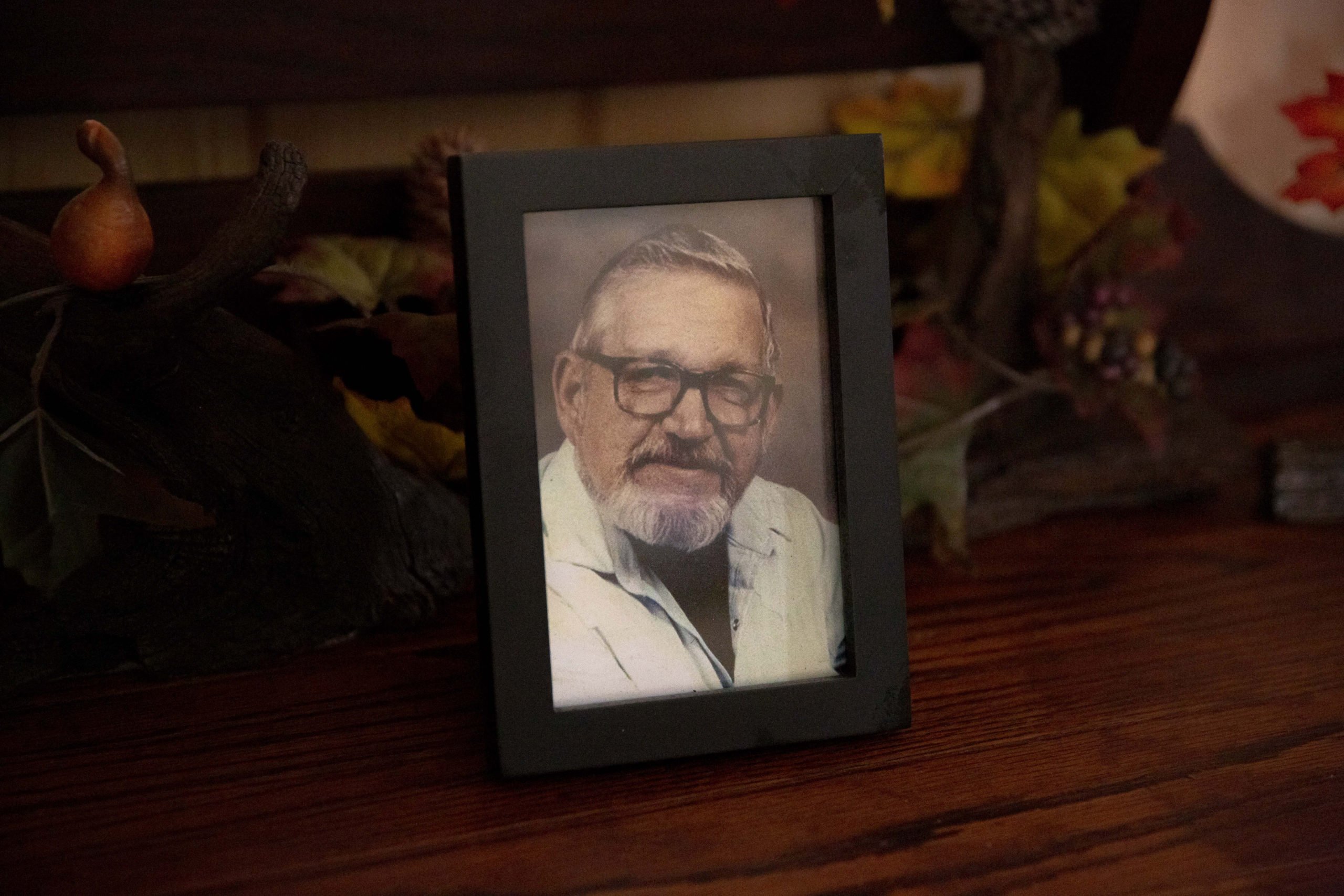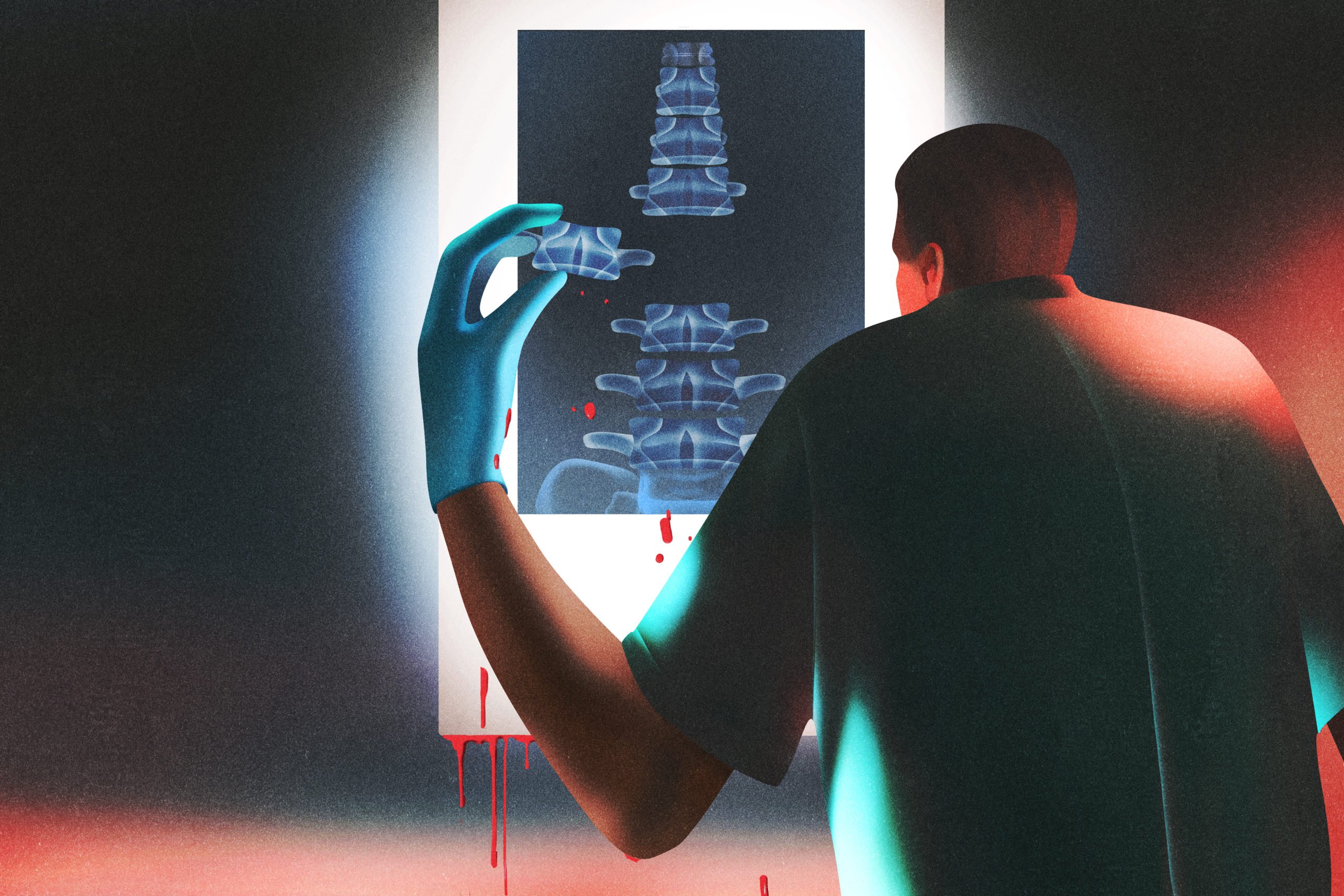Brenda Phillips hangs onto a Houston summer memory, circa 1996. It’s Friday night, she’s 26 years old and even though she’s sitting in gridlock traffic, she’s happy. When people in the cars around her begin opening doors and playing music, she joins in.
She’s single, has two wonderful daughters, and big ambitions: A graduate of Houston Community College, she’d already been working with domestic violence survivors and pregnant and parenting teens, and planned to apply to the Houston Police Academy to be a cop like her father.
Then that summer, while doing school custodial work for extra cash, Phillips hurt herself lifting a table. She reported the injury, received workers’ compensation coverage and was referred to an osteopath. But when she arrived for a follow-up appointment, she found a note on the door directing her elsewhere.
Confused, Phillips found the other suite—packed with what seemed like a hundred other patients. Eventually, a gorgeous man entered the room. Who is that? she remembers thinking.
She soon learned his name: Dr. Eric Heston Scheffey.
He ordered an MRI and a CT scan, and told her she had a herniated disc and was a candidate for a spinal fusion and a lumbar laminectomy—a surgery in which vertebral bone is removed to ease pressure on the spinal cord or nerve roots. Scheffey submitted a recommendation for surgery to her insurance provider and said he’d get her the treatment she needed.
Phillips trusted him, but had no idea who he really was.
For two decades, medical malpractice lawsuits and official complaints piled up against Scheffey. His medical license was suspended in 1986 and again in 1995, but both times the suspensions were reduced to probation. It wasn’t until 2005 that Texas finally revoked his license. When he was prosecuted for crimes related to patients, charges were abruptly dropped after a prosecutor said the state could not meet its burden of proof.
His story didn’t end there: He’s currently in litigation with the Securities and Exchange Commission for his part in an alleged $45 million stock fraud scheme. According to the complaint, he splits his time between homes in Denver and in Switzerland and, public records show, maintains a penthouse apartment in Houston, too.
Scheffey’s record, and the state’s failure to stop him years before, are shocking. Even more so, perhaps, are assertions by those who deal with the state’s medical regulatory system that there are likely more Scheffeys out there today.
“Looking at Dr. Scheffey, one isn’t likely to think he’s a monster,” said retired personal injury attorney Priscilla Walters, who spent years investigating Scheffey and his serial malpractice. “But he was a monster.”

Eric Scheffey was a highly paid orthopedic surgeon in Texas from 1982 to 2005. He was also killing and maiming people with his surgeries, public records show.
He was known around Houston for his art-filled mansion, fleet of fancy cars (at one point, he had seven Ferraris, a BMW, a Porsche, and a Mercedes), and his private jet. “He had parties where he invited the upper-crust society,” Walters said. “And he was charming and rich and he was happy to share his money.”
But within hospital walls, he was known by another name. “They called him ‘Eric the Red’ because he came out [of surgeries] completely covered in blood,” said Walters, who learned this from one of Scheffey’s colleagues.
By 2001, Scheffey topped a nationwide list of physicians who’d paid the most in malpractice settlements and was still practicing. By then, he’d made 29 payments totaling $8 million, according to a series on physician misconduct published by the Hartford Courant. By the end of his career, he’d been sued at least 72 times, records show.
His surgeries are blamed for more deaths in civil lawsuits and medical board records than were attributed to Christopher “Dr. Death” Duntsch, 51, the notorious Dallas neurosurgeon sentenced to life in 2017 for injuring an eldery patient.
At least five people died after surgery with Scheffey, at least two others committed suicide, and dozens more were left paralyzed, unable to work, or in debilitating pain, according to lawsuits and medical board records.
But Scheffey—unlike Duntsch—remains free and prosperous. He did not respond to multiple requests for comment.
Today the mechanisms used to expose his butchery in the 2000s are weaker. Tort reform—laws that tightened rules for civil litigation and imposed caps on the amounts plaintiffs can collect—decimated the number of personal injury attorneys capable of investigating medical malpractice in Texas. Medical privacy laws and confidentiality rules for peer review have tightened, making it harder for doctors and nurses to blow the whistle. And access has been restricted to the National Practitioners Data Bank—the only U.S. database that tracks disciplinary actions and malpractice settlements against doctors—which enabled the Hartford Courant to expose Scheffey as America’s king of serial medical malpractice.
“There are doctors … who are hurting as many people as Scheffey did who are flying under the radar because there is no radar anymore,” said personal injury attorney Michael Kerensky, who handled a lawsuit against Scheffey in the late 1980s. “The wisdom of [peer review] rests on the idea that doctors and the medical board will do a good job of policing their own. The Dr. Scheffey case is the poster child for why that’s not true.”
This is the story of Eric the Red and those who were harmed by him, fought back against him, and who will never forget what he did.
With thick hair and a wide smile, Scheffey had undeniable charisma and an impressive education. Scheffey attended medical school at the University of Texas Medical Branch, Galveston and the University of Texas Health Science Center at San Antonio. He did his residency in orthopedic surgery at the Medical University of South Carolina and became board eligible July 1, 1981.
But he never became a board certified surgeon: He failed the American Board of Orthopedic Surgery exam three times.
Scheffey set up shop on Price Street in Baytown, an industrial city near the Port of Houston. With easy access to a huge blue-collar workforce, he focused on workers’ compensation cases.
“There are doctors … who are hurting as many people as Scheffey did who are flying under the radar because there is no radar anymore.”
He gained privileges at several hospitals, including Gulf Coast, San Jacinto Methodist, and Humana-Baytown, but patients and nurses at San Jacinto Methodist quickly raised concerns. Internal memos from August 1983 mention erratic behavior and substance abuse, and describe rumors of Scheffey as a “cocaine user at times.” In one memo, the executive director of San Jacinto told Scheffey “It was important that he pace himself” in performing surgeries—the hospital was getting “too many patient complaints.” Scheffey argued that “he certainly has been admitting a lot of patients and [the hospital] ought to be happy.”
Then one of his Humana patients, Mary Tywater, bled to death.
Mary Tywater was first admitted to the hospital in April 1985 for a gynecological procedure, but had previously fallen while grocery shopping and injured her back. She was referred to Scheffey, who diagnosed a herniated disc and scheduled a lumbar laminectomy on May 23, 1985.
Tywater was wheeled into surgery around 3:30 p.m. Her daughter Donna (Goins) Sherill, then 18, and her son, Jimmy Goins, then 22, waited outside. “That day we were sitting there in the hallway and back then they had them code blue lights” outside operating rooms, Sherill recalls. That light soon started to flash.
Eventually, Scheffey appeared. “Well, I’m sorry, but we lost your mom,” he told the siblings, and then walked off, according to Sherrill.
“My brother Jimmy runs into the operating room,” she said. “He sees her laying there on her stomach, her tongue hanging out … and blood [was] just everywhere.”
The family filed a wrongful death lawsuit and learned during litigation that Tywater had lost more than 17 pints of blood during surgery—more than the human body generally holds. It took 55 minutes for Tywater to die from cardiopulmonary arrest. Later, her grieving children learned her surgery was unnecessary. Her death certificate lists the place of injury as “the operating room.”
“When something like this takes place, it just changes the whole course of life,” Sherill said. “It shook our whole family tree; it just shook it.”
The family settled the lawsuit for $2 million, split between Scheffey’s insurance and the hospital. Scheffey never reached out.
According to a deposition, on the weekend after Tywater’s death, Scheffey celebrated Memorial Day with friends at his Baytown waterfront home. They rode on his boat, swam in his pool, and hit golf balls into the water.
That Tuesday, he had appointments with patients, but never arrived at the hospital.
Sgt. Kelly Payne, then a motorcycle officer with the Pasadena Police Department, was rolling through town when his radio crackled with word of a disturbance at the local Montgomery Ward store. A white male, about 30 and dressed in surgical scrubs, was moving erratically through aisles and gathering items at random. He appeared intoxicated. Two officers were dispatched; Payne, already nearby, headed over to assist.
Upon arrival, Payne saw the man—Scheffey—in handcuffs. Scheffey’s black Jaguar was parked nearby. “He had pulled into the fire lane,” Payne said. “It looked like he almost wanted to drive into the store but couldn’t get through the door.”
Scheffey looked disheveled. His scrubs were sweaty and stained with dark brown splotches resembling blood. He was taken into custody. Payne and the other officers searched the Jaguar and found 30 grams of cocaine.
“When something like this takes place, it just changes the whole course of life. It shook our whole family tree; it just shook it.”
Scheffey was charged with possession of cocaine, a second-degree felony, based on the amount.
Officials at Gulf Coast, Humana, and San Jacinto hospitals suspended his privileges within days and his license to practice medicine was suspended on February 20, 1986, by the Texas State Board of Medical Examiners (now the Texas Medical Board).
But Scheffey fought back. Three weeks later, his license was reinstated and he received a 10-year probation, which required drug and alcohol treatment, monitoring, and compliance with “all state and federal laws regulating and pertaining to the practice of medicine.”
Then Scheffey caught another break. He received deferred adjudication on the cocaine charge in 1985 and a $2,000 fine. (He completed probation early in 1987, court records show.)
In 1986, Scheffey moved his office to Channelview and invested in hospitals, where he gained new operating privileges.
In June of 1986, he became a limited partner in Doctors Hospital 1984, Ltd. after contributing $40,000. The hospital’s general partner, Mid-America Hospitals, Inc., owned other hospitals where Scheffey gained privileges.
Malpractice lawsuits kept coming.
Walters, a former registered nurse-turned-attorney, represented over a dozen patients in suits against Scheffey in the 1990s and 2000s. She heard similar stories from different clients: Scheffey would get a new patient, typically covered by workers’ comp, gain their trust, misrepresent their condition, perform unnecessary surgeries—usually lumbar laminectomies—and then overbill.
“We heard over and over that Dr. Scheffey was charming and that some of his patients loved him,” Walters said. “His charm was part of his ability to draw the patients in and keep this going.”
Ancel “Bud” Freeman, a retired refinery worker, was Scheffey’s patient from September 1990 through November 1994. Freeman’s son, Aubrey, often accompanied his dad to appointments and said Scheffey “was always energetic.”
“And it was like: ‘Hey, how you doin’? What you feeling like, anything change?’ And it always seemed like he was here to fight for you,” Aubrey Freeman said.
Bud Freeman underwent two surgeries with Scheffey and then died in the ICU at Houston’s Westbury Hospital the day after the third procedure.
When Aubrey arrived, his dead father was lying sideways as if asleep.
“I grabbed his hand, crying, and one of the nurses asked, ‘Mr. Freeman, do you want an autopsy done?” he said. “And I told them, ‘No.’ I was trying to respect my dad’s wishes, and that’s one of the worst mistakes of my life.”

Aubrey and his sister later learned shocking details when an investigator from the medical board called about a complaint filed on their father’s behalf by a hospital staffer.
Freeman lost more than eight pints of blood during a seven-hour surgery. Scheffey performed the surgery alone, though hospital bylaws required a qualified assistant surgeon be present for complex operations involving patients like Freeman, a 65-year-old diabetic with a history of smoking.
“The OR staff … should have prevented the surgery from going forward,” an expert hired by the family concluded.
The Freemans sued for malpractice and wrongful death, but four years later, a jury ruled in Scheffey’s favor, finding no evidence of negligence. The presiding judge refused to allow attorneys to introduce evidence of Scheffey’s prior botched surgeries, malpractice settlements, or board discipline, which they’d hoped would prove a pattern versus a one-off surgical error.
When Scheffey heard the verdict, he pumped his fist in the air, Aubrey Freeman recalled. “To me, what he was doing jumping up and down [was] saying ‘Yes, I killed that guy’s dad and I got away with it.’ That’s what it was telling me,” he said.
Still, more malpractice lawsuits kept piling up. In September 1995, Scheffey allegedly hit a police officer who came to a hospital to serve notice of another suit. Scheffey said, “You think you’ve finally got me,” then struck the officer twice before walking off, court records show. Scheffey was charged with assault, but later acquitted.
In 1995, Scheffey’s license would be suspended—again—by the Texas Medical Board. This time for providing substandard care and overcharging patients.
Once again, Scheffey would lawyer up, fight back, and resume practicing medicine.

The Texas Medical Board is tasked with regulating doctors. But in the 1990s, the board lacked the authority to immediately suspend any physician’s license, even in an emergency. (In June 2003, the board gained the power to issue emergency suspensions, but only if a physician is proven to be a continuing threat to the public). Then (and now) years can pass between the beginning of an investigation and when a board’s final order takes effect; meanwhile, the physician under review is free to continue practicing.
The board’s second investigation into Scheffey began in 1989, stalled, and finally ended in 1995 when the board voted 5-3 to suspend (rather than revoke) his license, based on evidence from four patients. Scheffey again fought the suspension and ended up with another probation, which he appealed.
The new—and tougher—probationary order finally took effect in October 1997. Scheffey could no longer perform surgery without consulting another doctor and without having an assisting surgeon—both pre-approved by the board.
Ex-patients and their advocates figured even Scheffey could not meet those conditions and his practice would close. But that’s not what happened.
After the disciplinary order took effect, Scheffey claimed he was unable to obtain board approval for a consulting doctor or an assisting surgeon, according to a deposition. Around that same time, he purchased the practice of an elderly surgeon, Floyd Hardimon.
With that purchase, Scheffey gained new patients, including Brenda Phillips.
“When I found out that I was sold to him, I couldn’t imagine how,” Phillips said. “It just doesn’t make sense. But it happened.”
In turn, Hardimon became an employee of Scheffey’s company, East Harris County Orthopedic Associates, P.A. Together, they arranged that Scheffey would see patients at the office. Scheffey often recommended surgery, but claimed Hardimon was performing all operations and he was only assisting, records show.
But Scheffey was performing the surgeries, according to Walters, who said she discovered this while investigating him for medical malpractice in the early 2000s.
“The way I found out,” Walters recalled “is patients started mentioning to me, ‘I was told Dr. Hardimon was going to be my surgeon, but I saw him asleep on the stretcher in the operating room.’” Others told her they never met Hardimon at all.
“I ultimately found this nurse who told me that [the hospital] told the nursing staff to write down that Dr. Hardimon was doing the surgeries even though Dr. Scheffey was doing the surgeries.”
And the Pasadena hospital where they operated appeared to be covering this up, Walters alleged in litigation. “I ultimately found this nurse who told me that [the hospital] told the nursing staff to write down that Dr. Hardimon was doing the surgeries even though Dr. Scheffey was doing the surgeries,” Walters said. “So, this hospital was complicit in what he was doing.”
This had gone on so long that many patients could no longer file malpractice lawsuits because of a two-year statute of limitations. So Walters filed civil suits alleging healthcare fraud by Scheffey and Hardimon.
“The argument I had to make to the judge about Dr. Scheffey is: ‘This is not medicine,’” she said. “‘He’s cutting them with a knife—which, anywhere else, would be illegal—cutting them with a knife without reason … [and] using people’s bodies to generate income.’”
She remembers jumping up and down in the court room as she explained, “‘This is fraud, this is battery, this is murder. This is everything you could do to someone.’ And fortunately, those judges, because they saw how bad it was, they went with me on it.”
Even after Walters filed her cases (which she eventually settled on behalf of clients), Scheffey kept his medical license.
But when Walters submitted a request to the medical board for a certified copy of Scheffey’s 1995 disciplinary order, Nancy Higgs—the board’s new Head of Investigations of Standard of Care—arrived at Walter’s house to hand-deliver it.
Higgs had started at the Texas Medical Board in the summer of 2001, and worked for the board’s new Executive Director Dr. Donald Patrick. Patrick, a highly accomplished neurosurgeon and attorney, worried the state had been far too lax in enforcing standards.
Higgs was assigned to review “reams of every malpractice case that had happened” in recent years. She’d run across cases involving Scheffey, and then one day, she spotted boxes upon boxes of records labeled with his name in an office at the medical board. Scheffey’s cases were so voluminous, they were “a dinosaur no one really wanted to delve into,” a staff attorney explained.
Higgs dove in and instantly realized things were wrong. “Almost all low back pain can be healed with just rest and therapy,” Higgs said. “Almost none requires surgery … [and] he had maimed these people.”
One case involved Brenda Phillips.
When Phillips talks about how nice Scheffey seemed, she imitates him, slowing her voice into a welcoming drawl. “Trust me,” he’d say, his hand on her knee, “I’m on your side, we’re in this together. You have my word. Don’t worry, sweetie … you don’t have to suffer anymore.”
Phillips had her first surgery with Scheffey on September 8, 1998. Initially, she felt better, but soon began feeling shocks. She returned to Scheffey, who Phillips said had inserted an electrical bone growth stimulator without her knowledge. She asked him to remove it.
In April 1999, she had another surgery, supposedly to remove the stimulator, but Scheffey simultaneously re-explored the spinal fusion and replaced hardware in an unauthorized procedure. Phillips did not heal, prompting a third surgery in 2000.
By 2001, Phillips, a mom in her early 30s, developed drop foot, major depressive disorder, and loss of bladder control. “Those three surgeries destroyed my life,” Phillips said.
She looked for another doctor, but found that “no one would see me or treat me” after learning she’d seen Scheffey. “Once I realized I was stuck with him, I went back because I needed medicine; I had to get refills. … He was adamant about me having a fourth surgery.”
Phillips refused and looked for a lawyer. She also began poking into Scheffey’s past. “It was like a whole can of worms opened up,” she said. “He’s killed people; he’s mangled people; he’s hurt people; he’s been caught with cocaine. … This man should go down as the worst doctor in history. ”
She hoped this time, the medical board would finally stop him.
“He’s killed people; he’s mangled people; he’s hurt people; he’s been caught with cocaine. … This man should go down as the worst doctor in history. ”
Based on records from Phillips and other patients, Higgs prepared a disciplinary case that proved Scheffey was a continuing threat to the public. On August 26, 2003, his license was placed on emergency suspension.
On February 4, 2005, the board found, by reviewing 11 patients’ cases, that Scheffey had performed 29 unnecessary surgeries and revoked his license. They issued an $845,000 fine, the highest levied against an individual doctor in board history.
Scheffey did not attend that hearing, Walters said.
Two months later in April 2005, Scheffey’s company—Harris County Bone and Joint Clinic Association—pled guilty to third-degree felony insurance fraud in Travis County in a related criminal case, and his company was ordered to pay $24,599 in restitution. Charges against Scheffey as an individual were dismissed.
Phillips was disappointed that Scheffey avoided a conviction. “I wanted [Scheffey] to go to prison,” Phillips said. “People had been dying all along. … The way it happened is if they didn’t die during surgery, they died after with complications, and if they didn’t die from the complications, they died because they overdosed from him giving them so much medicine.”
Then in August 2005, Scheffey was charged in Harris County with five counts of practicing medicine without a license for seeing patients after his Texas license had been suspended.
This time, Scheffey faced a maximum sentence of 50 years. Five former patients, all disabled, testified, but on February 9, 2007, three days into trial, the charges against him were dropped.
Attorney Dick Deguerin successfully defended Scheffey by arguing he “could no longer practice medicine, but had hundreds of patients and so he had to … transition those patients to someone else.”
“[I’d] wager that of 40,000 patients, you’ll find less than 1% dissatisfied with him,” DeGuerin said. “When you operate on that many people, there are gonna be some bad results.”
Rob Freyer, the assistant district attorney on the Harris County case, still works as a prosecutor for another county. In an interview for this story, Freyer said it was a disappointing result. “Eric Scheffey is the luckiest doctor in the world, his patients not so much. He managed to do what he has done and in the process made a lot of people’s lives very unhappy,” he said.
Prosecuting doctors—especially for crimes allegedly committed during surgery—remains rare. That’s why the conviction of another Texas surgeon dubbed “Dr. Death” in 2017 made national news.
Dallas County Assistant District Attorney Michelle Shughart took two years to prepare a case against Dr. Duntsch, who had been accused of injuring at least 32 patients, two of whom died. Shughart and her team considered filing charges of fraud, or of aggravated assault with hands and a scalpel as the weapon, but eventually settled on injury to an elderly person—a first-degree felony—for his treatment of Mary Efurd.
“I was able to argue that his knowledge from all his previous surgeries went to his intent,” Shughart said. “By the time he got to [Efurd], he knew he was gonna hurt her because he had just maimed his last six patients.”
Shughart said she was fortunate because some doctors volunteered to review patient records or to testify for free as fact witnesses instead of experts, which made the case financially possible. But that’s not the norm.
“Doctors don’t like to talk about other doctors,” she said. “There’s kind of a code because someday they might talk about you.”
She still feared a jury might side with the surgeon. “I was super nervous the whole time,” she said. “Would they convict a doctor or think he’s an upstanding guy who had a bad day?”
After four hours of deliberations, Duntsch was found guilty. He was sentenced to life in February 2017.
Shughart has since spoken with a handful of other DAs building similar cases, signaling a new wave of accountability could be coming.
But prosecutions, civil lawsuits, and even disciplinary cases of any problematic doctor generally require patients, medical officials, and hospital leaders to cooperate.

Once his criminal charges were dropped, Scheffey vowed to get his license back. Then on March 28, 2007, his office at 9343 N Loop E in Houston burned down in a four-alarm fire that began elsewhere in the building. Scheffey left the city after that, though his Texas business entity, East Harris County Orthopedic Associates, P.A. retains the right to do business in Texas, state records show.
But this was not the end of his story.
On March 2, 2021, a press release went out from the SEC stating the agency had charged seven individuals, including Scheffey, with a fraudulent scheme to gain control of Airborne Wireless Network (formerly Ample-Tee, Inc., a company focused on “selling hard-to-find ergonomic products for the physically disabled”), promote its stock, and defraud investors.
The complaint alleges that Scheffey became involved in fraud via his Denver tennis instructor. In October 2016, he purchased 312,500 restricted Airborne shares for $250,000. Then in November 2016, he purchased an additional 1.5 million shares for $1.2 million, which was transferred from an account in someone else’s name. That same month, Scheffey flew to California to a meeting in a hotel restaurant near the Hollywood Burbank Airport, where he and his co-conspirators allegedly falsified paperwork and backdated shares of Ample-Tee stock in his name so it appeared Scheffey had purchased them from the original Thai shareholders in 2015, according to the SEC.
“The goal of this deception,” according to the SEC complaint, “was to have Airborne’s Transfer Agent cancel the Ample-Tee S-1 Shares in the Thai Shareholders’ names and reissue Airborne shares in Scheffey’s name … which made the shares easier to deposit with a broker and monetize.” In addition, Scheffey was given some shares for free to deceive the market about the price of and demand for Airborne stock, the government alleged. In total, Scheffey obtained over 2.8 million shares, which he began to sell in July 2017. He made over $500,000 from investors in two weeks, the complaint says.
SEC officials declined comment, but released a June 24th joint motion stating “the SEC staff and Defendant Scheffey have agreed on settlement terms that the staff will recommend to the Commission.” Final approval is pending. Neither Scheffey nor his attorney responded to an interview request.
Meanwhile, the damage he caused in Texas has never been forgotten by Brenda Phillips and others he harmed. “This monster is getting away … over and over,” Phillips said. “And nobody is saying a thing.”
Since the early 2000s, Phillips has needed a hip replacement, knee replacement, and foot reconstruction, and remains in constant pain that she attributes to Scheffey’s botched surgeries. At one point, Phillips sued. But she went “through the ringer” to find an attorney, and obtained only a $50,000 settlement, which she said her lawyer convinced her to take. After paying her lawyer, comp carrier, and others she was left with about $8,000.
“I’ve done a lot over the years; I have tried to forget about him but I can’t,” Phillips said. “I didn’t receive a trial; I didn’t receive a fair settlement; and I didn’t receive fair justice.”
She continues to post on social media about Scheffey and is working on a book, A Devil in a White Coat, which includes her own experience and those of others she met along the way. “I’m fighting for the people who he’s killed because they can’t fight for themselves anymore,” she said. “I know [my case] is 20 years old, but guess what? It’s just like it was yesterday. … My pain will never go away, but justice I will seek until the end.”
Featured Illustration by Ibrahim Rayintakath



